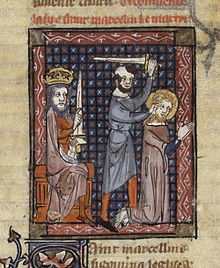Pope Marcellinus
Marcellinus | |
|---|---|
| Bishop of Rome | |
 Medieval miniatureshowing the martyrdom of Saint Marcellinus | |
| Church | Early Christianity |
| Papacy began | 30 June 296 |
| Papacy ended | 304 |
| Predecessor | Caius |
| Successor | Marcellus I |
| Personal details | |
| Born | unknown date Rome,Roman Empire[1] |
| Died | 304 Rome, Roman Empire |
| Sainthood | |
| Feast day | 26 April (Catholic) 7 June (Serbian Orthodox) |
Pope Marcellinuswas thebishop of Romefrom 30 June 296 to his death in 304. A historical accusation was levelled at him by some sources to the effect that he might have renouncedChristianityduring EmperorDiocletian'spersecution of Christiansbefore repenting afterwards, which would explain why he is omitted from lists of martyrs. The accusation is rejected, among others, byAugustine of Hippo.He is today venerated as a saint in theCatholic Churchand in theSerbian Orthodox Church.
Pontificate[edit]
According to theLiberian Catalogue,Marcellinus was a Roman, the son of Projectus. He succeededCaiusasbishop of Romeon 30 June 296.[1]Marcellinus' pontificate began at a time whenDiocletianwasRoman emperor,but had not yet started topersecute the Christians,and their membership grew.CaesarGaleriusled thepaganmovement against Christianity and aroused Diocletian against Christians in 302; first, Christian soldiers had to leave the army, later the Church's property was confiscated and their books destroyed. After two fires in Diocletian's palace, he took harder measures; Christians had to apostatize or be sentenced to death.
Marcellinus is not mentioned in theMartyrologium hieronymianum,or in theDepositio episcoporum,or in theDepositio martyrum.TheLiber Pontificalis,based on the lostActs of St Marcellinus,relates that duringDiocletian’s persecution, Marcellinus offered incense toidols,but that, repenting shortly afterwards, he re-confessed the faith of Christ and sufferedmartyrdomwith several companions. Other documents speak of his defection, and it is probably this lapse that explains the silence of the ancient liturgical calendars. In the beginning of the 5th century,Petilianus,theDonatistbishop ofCirta,says that Marcellinus and his priests had given up the holy books to the pagans during the persecution and offered incense to false gods.Augustine of Hippodenied the affair.[1][2]The records of thepseudo-Council of Sinuessa,whichwere fabricatedat the beginning of the 6th century, state that Marcellinus after his fall presented himself before a council, which refused to try him on the ground thatprima sedes a nemine iudicatur( "The first See is judged by none" ).[2]
According to theLiber Pontificalis,Marcellinus was buried on 26 April 304 in the cemetery ofPriscilla,on theVia Salaria,25 days after his martyrdom; the Liberian Catalogue gives as the date 25 October. The fact of the martyrdom, too, is not established with certainty. After a considerable interregnum, he was succeeded by Marcellus, with whom he has sometimes been confused.[2]
Veneration[edit]
Marcellinus was mentioned in theGeneral Roman Calendar,into which afeast dayin his honour jointly with that ofSaint Cletuson 26 April was inserted in the thirteenth century.[3]Because of the uncertainties regarding both, this joint feast was removed from that calendar in 1969.[3]Saint Cletus is still listed in the Roman Martyrology under 26 April date; but Saint Marcellinus is no longer mentioned in that professedly incomplete list of recognized saints.[4]Pope Marcellinus, along with Pope Marcellus, is commemorated in the Serbian Prologue of Ohrid on 7 June according to theJulian Calendar.[5]
See also[edit]
Notes[edit]
- ^abcKirsch, Johann Peter. "Pope Saint Marcellinus." The Catholic EncyclopediaVol. 9. New York: Robert Appleton Company, 1910. 28 September 2017
- ^abcThis article incorporates text from a publication now in thepublic domain:Delehaye, Hippolyte(1911). "Marcellinus, St".Encyclopædia Britannica.Vol. 17 (11th ed.). p. 684.
- ^abCalendarium Romanum (Libreria Editrice Vaticana 1969), p. 121
- ^Martyrologium Romanum (Libreria Editrice Vaticana 2001ISBN88-209-7210-7)
- ^"Prologue from Ochrid".Archived fromthe originalon 9 May 2012.
